
This week, Judge Bryson issued his findings of fact and conclusions of law following trial in Janssen Pharmaceuticals, Inc., v. Tolmar, Inc., C.A. No. 21-1784-WCB (D. Del. Feb. 26, 2024), and ANDA action. The opinion is long and thorough, and I thought the section on enablement was worth noting.
The patent at issue covers a "dosing regimen" for giving an anti-psychotic drug "to a psychiatric patient in need of treatment for psychotic disorder." According to the method, two loading doses of the drug are given, and then a maintenance dose is given between 21 and 38 days later (a "17-day window").
Defendant argued that the patent was not enabled, first because a person of skill wouldn't understand how to give the drug in an effective way within the 17-day window, and second because they wouldn't know how to use the drug to treat all psychotic disorders—i.e., the "full scope" of the claim:
[Defendant] Tolmar argues that the ’906 patent does not enable a person of ordinary skill in the art to practice the claimed invention, for two main reasons. First, Tolmar argues that an ordinary artisan would not be able to administer maintenance doses within the claimed 17-day window because it would not be clear which dose volume to select or how frequently to administer the doses. Dkt. No. 140 at 66 (citing TD1 201:15–202:17, 344:14–20); see also Dkt. No. 140 at 74; id. at 69 (explaining that an ordinary artisan would not know how to “maintain or achieve target plasma concentrations of paliperidone” using the claimed method “without undue experimentation”). Second, Tolmar argues that a person of ordinary skill in the art would not be able to treat all psychotic disorders with the claimed dosing regimen, as both paliperidone palmitate and long-acting injectables are unsuitable for many applications.
Id. at 53.
The problem? The claims don't actually require the drug to work:
Both arguments incorrectly assume that enablement requires disclosure of how to achieve a desirable result using the invention. Enablement requires only that the specification impart to a person of skill in the art the ability to practice “the invention as defined by its claims.” Amgen Inc. v. Sanofi, 598 U.S. 594, 610 (2023) (emphasis added). It is not necessary to “maintain or achieve target plasma concentrations of paliperidone” in order to practice the claims. Nor is it necessary that it be good practice to treat a patient with every psychotic disorder according to the claimed method. As such, neither of Tolmar’s arguments is directed to enabling the person of ordinary skill in the art to practice the invention as defined by its claims.
To the contrary, the claims themselves are sufficiently clear that an ordinary artisan would plainly be capable of practicing them. As Janssen’s witness Dr. Patrick Sinko explained, the claims are “almost like a recipe,” “a series of steps that you have to follow,” and “it’s very easy to follow those steps.” . . . . Practicing the claimed regimen does not require any experimentation at all, let alone undue experimentation. Because Tolmar has not demonstrated any need for experimentation, it has not met its burden of proving lack of enablement.
Id. at 53-54.
At first this feels like a surprising result—after all, what is the point of the claims to a dosing regiment for an anti-psychotic drug if not to actually treat the disease?
But if you look at the claims closely, they never actually say it has to be effective. Here is one claim's preamble, describing what the claim actually covers:
A dosing regimen for administering [the drug] to a psychiatric patient in need of treatment for psychotic disorder comprising [various steps]
This doesn't actually require any "treatment" to take place at all. All it requires is giving the drug to someone who needs treatment—even if it's totally ineffective. And it doesn't take any experimentation at all to administer the drug in a totally ineffective way.
If you enjoyed this post, consider subscribing to receive free e-mail updates about new posts.





